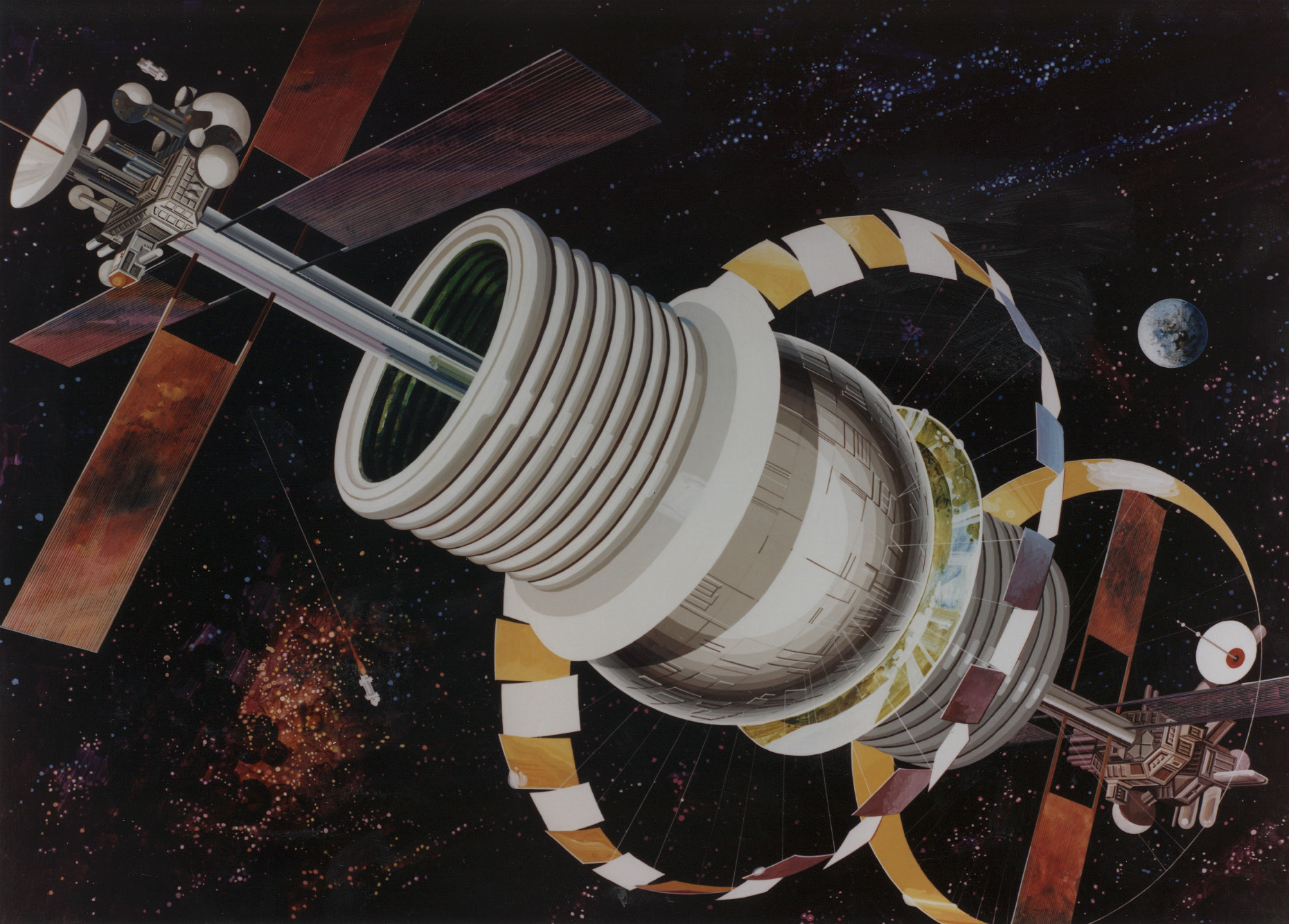Space Habitat
Commonly shortened to hab, a large spaceborne structure capable of supporting a permanent population.
For lighting, some habitats use mirrors and windows, but this wastes large portions of inner surface area and is only effective within a system's habitable zone. Thus, most instead use a glowing line running down the center and set to cycle through colors and brightness levels throughout the day. Power for this is usually provided by fusion reactors or solar collectors, depending on whether the habitat is located close enough to its sun to get useful amounts of light.
To support differing environments (for instance, an arctic forest alongside a grassy plain, or shallow sea), a habitat's interior volume can be separated by internal dividers, or separate pressure vessels can be built and stacked end-to-end.
Radiation shielding is another concern; about three meters or so of packed regolith around the habitat is required to reduce radiation dosage inside to long-term safe levels. This can be built as a "jacket" inside which the hab spins, or the cylinder can be built inside a hollowed-out rocky asteroid instead. A metallic asteroid is the ultimate in space habitat construction, a large cavity can be dug out of the interior and the entire thing given a spin to create a fortress-habitat protected by potentially kilometers of solid metal, rendering it immune to virtually everything save relativistic kinetic weapons.
Another common feature of many habitats is a series of separate agricultural modules. Growing crops in multiple redundant environments separate from the occupants reduces the risk of disease and sabotage, as well as providing extra layers of redundancy.
History
Space stations were first used during the Age of Prosperity, but it was not until the mastery of ecotech that self-sustaining inhabited structures became possible. Early habs were small, fiendishly difficult to maintain, and required regular shipments of imports to make up for losses in their recycling systems. These flaws were eventually rectified, and as the state of the art of space-based construction grew, the first modern full-sized habs emerged.Structure and Types
The distinction between a space habitat and a space station is generally taken to be the point at which the interior is large enough to contain an open environment, such as an imitation of a natural landscape or planet-side city. Gravity is provided by rotation, hence most habs resemble cylinders, toruses, or spheres, with centripetal force keeping objects and people planted on the inside./**/
/**/
This area ranges in size from a little park-like area at the center of a small drum-like station crammed with equipment and living quarters under the floor to vast open cylinders kilometers across, complete with clouds, lakes, and hills. In a cylindrical habitat, the ends are topped with flat or rounded "endcaps" which feature free-fall sections up at the axis of rotation. Additional non-rotating sections can be built off either end to serve as spaceports, industrial facilities, etc. A person standing inside the habitat and looking down the long axis will see the landscape curving up to either side like a valley that meets overhead. There is no horizon, with binoculars or acute enough eyesight one can observe activity on the habitat's other side. If visiting a planetary surface, a lifelong habitat-dweller can feel they are standing on an island of trees and buildings floating in an endless cloudy blue sky.For lighting, some habitats use mirrors and windows, but this wastes large portions of inner surface area and is only effective within a system's habitable zone. Thus, most instead use a glowing line running down the center and set to cycle through colors and brightness levels throughout the day. Power for this is usually provided by fusion reactors or solar collectors, depending on whether the habitat is located close enough to its sun to get useful amounts of light.
To support differing environments (for instance, an arctic forest alongside a grassy plain, or shallow sea), a habitat's interior volume can be separated by internal dividers, or separate pressure vessels can be built and stacked end-to-end.
Radiation shielding is another concern; about three meters or so of packed regolith around the habitat is required to reduce radiation dosage inside to long-term safe levels. This can be built as a "jacket" inside which the hab spins, or the cylinder can be built inside a hollowed-out rocky asteroid instead. A metallic asteroid is the ultimate in space habitat construction, a large cavity can be dug out of the interior and the entire thing given a spin to create a fortress-habitat protected by potentially kilometers of solid metal, rendering it immune to virtually everything save relativistic kinetic weapons.
Another common feature of many habitats is a series of separate agricultural modules. Growing crops in multiple redundant environments separate from the occupants reduces the risk of disease and sabotage, as well as providing extra layers of redundancy.
Space Habitat
The interior of a space habitat as its primary eclipses its sun.
Remove these ads. Join the Worldbuilders Guild




Comments